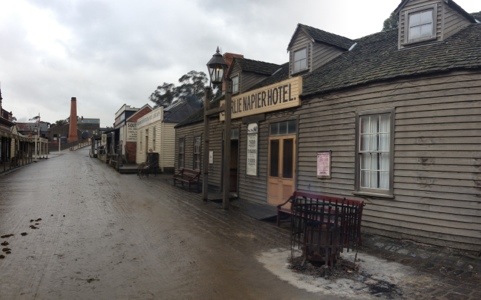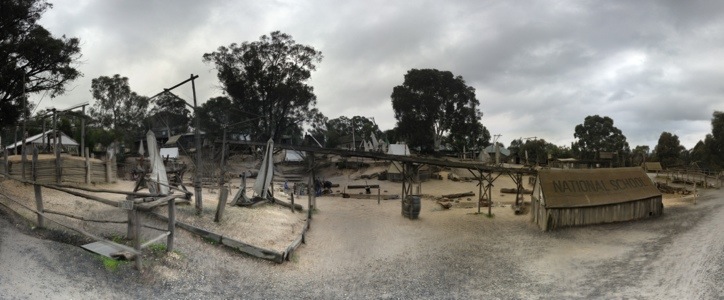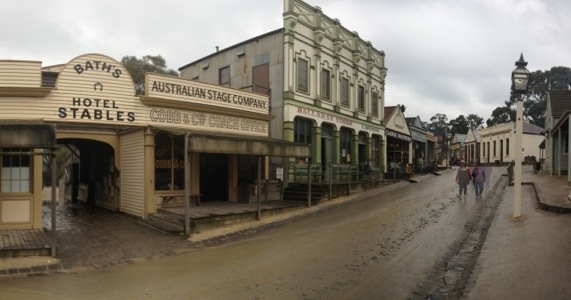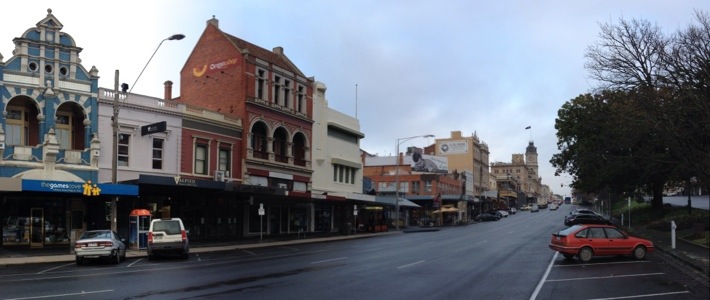I recently had to go to Ballarat on business, and by good fortune, finished up early.
I thought rying to find something to do in a place like Ballarat, in the depths of winter, on a weekday, for half a day was going to be a tall order… Until I found Sovereign Hill.
Sovereign Hill is an open air museum in Golden Point, a suburb of Ballarat. It depicts Ballarat’s first ten years after the discovery of gold there in 1851, and it’s huge, sprawling over a 25 hectare site. You really need a whole day (or even two) to see it properly.
The site is basically a whole town of historically recreated buildings, with period-costumed staff and volunteers.
Goods for sale in the General Store

The recreation is completed with antiques, artwork, books and papers, machinery, livestock and animals, carriages and devices all appropriate to the era.
All the shops are “working” shops. That is to say, they mostly make what they sell right there. The town newspaper really prints newspapers, the blacksmiths makes and sells his wares, straight from the forge in his own shop. The girls in the sweet shop make all 50 odd varieties of their boiled lollies right there (and they are soooo good).
Recreation of the old hotel, looking towards the Mine works

Apparently the main street is loose reconstruction of Main Street, Ballarat East which was once the settlement’s umm… main street (possibly overusing the word “main” a bit there).
the modern Main St. of Ballarat. Note they are all brick.
The real one was burnt down in a large fire during the 1860s and a more substantial town centre planned around Sturt and Lydiard Street in Ballarat West.
Seattle had a similar issue, with a big fire burning down the city center in the gold rush days. They, too, passed an ordinance that all future buildings had to be brick.
Gold panning creek, and the Chinese area.

The gold diggings are right at the beginning of the complex. They have constructed a winding creek in which visitors are able to pan for real gold, although if any is actually in there, I’d be surprised. Still, it gives you a sense of what life on the gold fields was like, particularly on the cold, wet, dreary day I was there.
Life in those canvas tents, enduring sub-zero winters and forty degree summers would have been pretty tough. Prices for food were so high, due to demand, many couldn’t afford decent food. Being the sort of people to travel from afar, keen to make their fortune on the gold field, what they didn’t spend on food was spent in the gambling houses instead.
The Chinese had it particularly rough. There’s a good article on Chinese emigration to Australia here. They had very little when they arrived, were actively discriminated against by the locals, unfairly taxed, lived in bark and hessian huts and sent every scrap they earned back home to feed there starving families there. No wonder they left the country as soon as possible.
Reflecting on the period, I think the only people that actually made a living in the gold fields were those selling stuff to the endless stream of hopefuls that actually wanted to do it.
I left the museum with a much better appreciation for life in Australia 150 years ago. If you are ever in the area, I’d recommend a visit.



